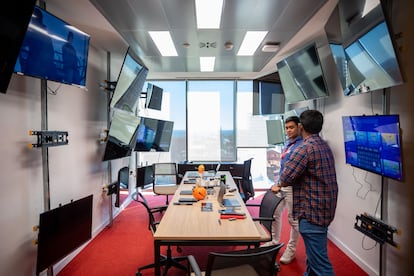From 6K resolution and DTS:X sound to the phone in your pocket: The challenge of democratizing the technical quality of streaming
Adapting their contents to all types of devices, models and systems is no small task for the entertainment platforms


The career of Wim Wenders is closely linked to the documentary genre, and art, along with nature, is one of his recurrent topics. Thus, the German filmmaker has become a visual chronicler of the talent of other creators — and along the way, one of the great advocates of 3D technology. He used it to capture the dance of his friend Pina Bausch and, years later, with an improved technique, he dedicated his latest film to the work of painter and sculptor Anselm Kiefer. Wenders still believes that the future of cinema will be projected in three dimensions. That is why he decided to shoot in 6K resolution when current film projectors and televisions can only reproduce 4K; he is thinking about tomorrow, as he explained recently at the Zurich Film Festival, where he screened Anselm before an audience equipped with stereoscopic glasses.
Something similar happens with the new audio decoder DTS:X. The technical managers of Spanish on-demand content platforms such as Rakuten TV are already testing this system, which takes surround sound one step further, and which the brands will gradually incorporate into their televisions in the near future. This international platform of Spanish origin offers online rental and purchase, a subscription catalog and free shows and movies with ads, and the technical quality of all these contents is increasingly important. This is why, when the company moved recently to a new location, it took the opportunity to ask its employees how they could improve their facilities, now located in the 22@ district, an area of Barcelona where many technology companies are currently headquartered.
The Rakuten TV technical department made those in charge aware of the importance of dedicating a space to testing the quality of the image and sound. For this reason, the architectural project — designed together with the firm CBRE Design Collective — assigned practically an entire floor to one of the great challenges of streaming platforms: ensuring that its series and movies can be viewed properly on the infinite number of devices on which they can be played, taking everyone into account, from those who have a home theater with a projector or a huge HD screen and an immersive 7.0 sound system, to those who watch series with a phone and a pair of headphones on the way to work. Or a laptop. Or a tablet. Or a regular television, be it Samsung, LG, Huawei or any other brand.

In addition to their own testing rooms, called TV labs, Rakuten TV has two storage spaces that serve as device libraries with all types of televisions, classified by model and year. The most notable thing is a soundproof room shaped like a living room with two screens; it can become completely dark, and experts use it to test the audio and image as users experience it at home. “It serves to compare how the content is viewed on two different televisions, and also to compare our quality with that of the competition,” explains Carles Amigó, the company’s CTO. His team also created a remote laboratory that allows technicians to evaluate different televisions without leaving their homes, with cameras that record the performance of the different models. During the pandemic, the company’s employees were able to take the different tablets and mobile phones they worked with, but in the case of televisions their work became complicated.
The task of these departments is not only to guarantee the highest possible image and sound quality, points out Manuel Gómez Zotano, director of Interactive Technology at the platform rtve.es, but also the lowest and all the intermediate ranges, so that every viewer can consume their product on the device they have at hand and regardless of the quality of their connection. “You have to build a map of correspondences between the devices and their capabilities, with an empirical, trial and error system. The most problematic are the devices that are becoming outdated, but to which we have to continue to provide service, despite the evolution of the industry,” he says. The platforms also have to keep their digital archives up to date. “We started producing digital video on a massive scale in 2004, but the formats and quality from then have nothing to do with the players of 2023. That also needs to be updated,” he explains.
Sign up for our weekly newsletter to get more English-language news coverage from EL PAÍS USA Edition
Tu suscripción se está usando en otro dispositivo
¿Quieres añadir otro usuario a tu suscripción?
Si continúas leyendo en este dispositivo, no se podrá leer en el otro.
FlechaTu suscripción se está usando en otro dispositivo y solo puedes acceder a EL PAÍS desde un dispositivo a la vez.
Si quieres compartir tu cuenta, cambia tu suscripción a la modalidad Premium, así podrás añadir otro usuario. Cada uno accederá con su propia cuenta de email, lo que os permitirá personalizar vuestra experiencia en EL PAÍS.
¿Tienes una suscripción de empresa? Accede aquí para contratar más cuentas.
En el caso de no saber quién está usando tu cuenta, te recomendamos cambiar tu contraseña aquí.
Si decides continuar compartiendo tu cuenta, este mensaje se mostrará en tu dispositivo y en el de la otra persona que está usando tu cuenta de forma indefinida, afectando a tu experiencia de lectura. Puedes consultar aquí los términos y condiciones de la suscripción digital.
More information
Archived In
Últimas noticias
Not all insomnia is the same: Study identifies five subtypes and paves the way for personalized treatment
The United States designates Clan del Golfo as a foreign terrorist group
The United States strikes three more suspected drug boats, killing eight
The Iberian Peninsula is rotating clockwise, scientists report
Most viewed
- ‘El Limones’ and the growing union disguise of Mexican organized crime
- Christian Louboutin: ‘Young people don’t want to be like their parents. And if their parents wear sneakers, they’re going to look for something else’
- ‘We are dying’: Cuba sinks into a health crisis amid medicine shortages and misdiagnosis
- A mountaineer, accused of manslaughter for the death of his partner during a climb: He silenced his phone and refused a helicopter rescue
- The low-cost creative revolution: How technology is making art accessible to everyone










































